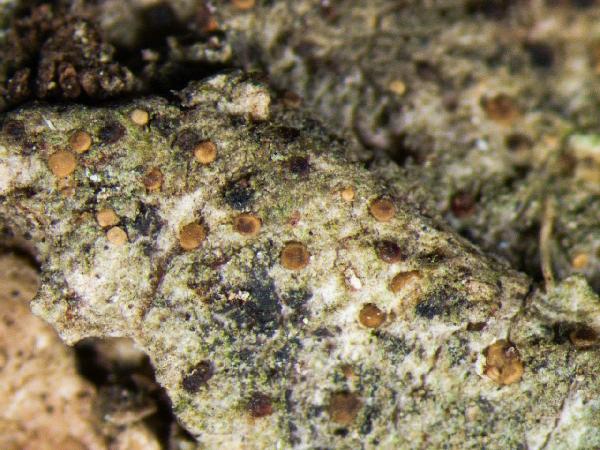Bacidina assulata (Körb.) S. Ekman
Opera Bot., 127: 116, 1996. Basionym: Bacidia rubella var. assulata Körb. - Parerga Lichenol.: 131, 1860.
Synonyms: Bacidia anomala A. Massal.; Bacidia assulata (Körb.) Vězda; Bacidia effusa auct.; Bacidina delicata auct. p.p. non (Leight.) V. Wirth & Vězda; Bacidina mendax Czarnota & Guzow-Krzem.
Distribution: N - TAA (Nascimbene & al. 2007b), Lomb. C - Tosc, Sar (Zedda 2002). S - Camp (CLU 17515), Pugl (Jatta 1909-1911), Bas (Jatta 1909-1911), Cal (Jatta 1909-1911), Si.
Description: Thallus crustose, episubstratic, continuous to granulose, whitish or greenish grey, partially dissolved into loosely aggregated, 16-29 μm wide goniocysts in small patches. Apothecia biatorine, 0.3-0.6 mm across, pink, brown-orange or purple-brown, often mottled, with a flat, epruinose disc and a concolorous, distinct proper margin. Proper exciple laterally c. 60 μm wide, without crystals, of rather thin-walled (2-3 μm), radiating hyphae, orange-brown in the outer rim, colourless within; epithecium orange-brown, scarcely differentiated from the hymenium; hymenium colourless in lower part, orange-brown in upper part, 60-75 μm high; paraphyses c. 1.2 μm thick at mid-level, the apical cells 2.5-3.5 μm wide, without internal pigment; hypothecium colourless or very pale yellow; all pigmented parts of apothecia K+ intensifying, N-. Asci 8-spored, clavate to cylindrical-clavate, the apical dome K/I+ dark blue with a pale, conical-pointed apical cushion (axial mass) never penetrating through the entire d-layer, the wall K/I-, but the thin outer gel K/I+ blue, Bacidia-type. Ascospores 5-9-septate, needle-like, straight or curved, 34-45(-54) x 1.5-2.5 μm. Pycnidia immersed, colourless. Conidia 1-celled, filiform, strongly curved, 10-43 x (0.5-)0.8-1 μm. Photobiont chlorococcoid, the cells 5-12 μm in diam. Spot tests: thallus and apothecia K-, C-, KC-, P-, UV-. Chemistry: thallus without lichen substances; apothecia with the Rubella-orange pigment. Note: an often misunderstood species (see Ekman 1996) growing on acid to subneutral bark in rather sheltered and humid situations. Italian material needs revision. It is included in the Italian red list of epiphytic lichens as “Data Deficient” (Nascimbene & al. 2013c).
Growth form: Crustose
Substrata: bark
Photobiont: green algae other than Trentepohlia
Reproductive strategy: mainly sexual
Commonnes-rarity: (info)
Alpine belt: absent
Subalpine belt: absent
Oromediterranean belt: absent
Montane belt: absent
Submediterranean belt: very rare
Padanian area: absent
Humid submediterranean belt: very rare
Humid mediterranean belt: absent
Dry mediterranean belt: absent

Predictive model
Herbarium samples
Growth form: Crustose
Substrata: bark
Photobiont: green algae other than Trentepohlia
Reproductive strategy: mainly sexual
Commonnes-rarity: (info)
Alpine belt: absent
Subalpine belt: absent
Oromediterranean belt: absent
Montane belt: absent
Submediterranean belt: very rare
Padanian area: absent
Humid submediterranean belt: very rare
Humid mediterranean belt: absent
Dry mediterranean belt: absent

Predictive model
| Herbarium samples |
 Index Fungorum
Index Fungorum
 GBIF
GBIF


